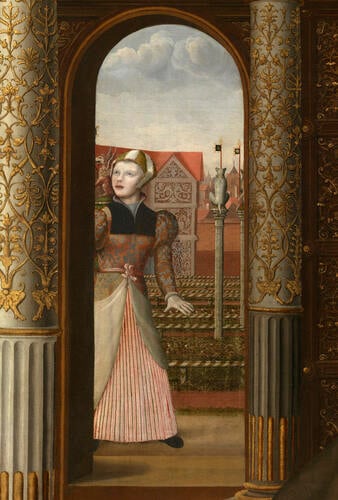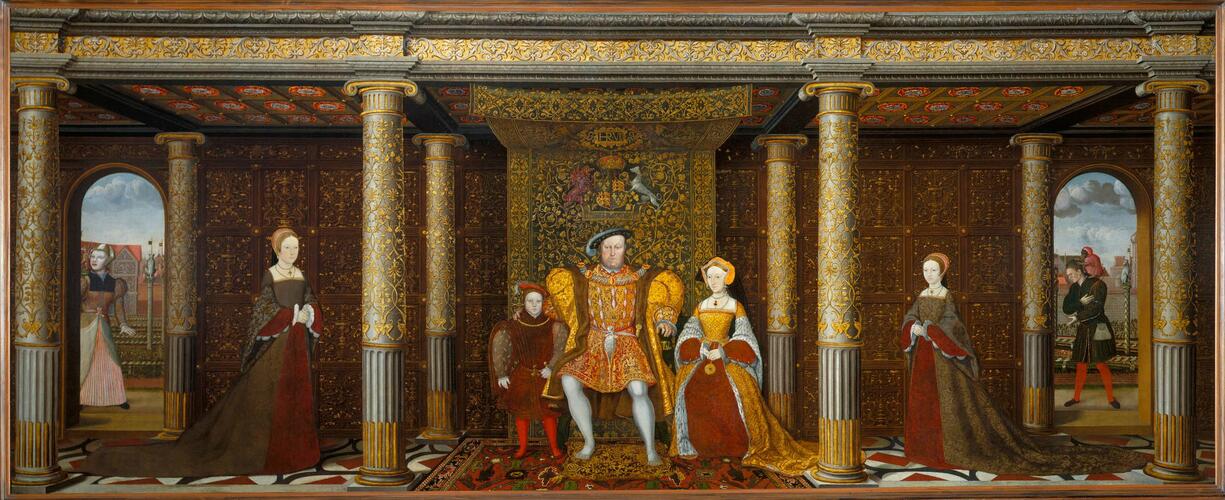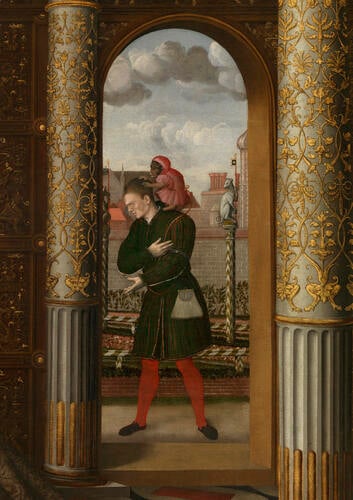-
1 of 253523 objects
The Family of Henry VIII c. 1545
Oil on canvas | 144.5 x 355.9 cm (support, canvas/panel/stretcher external) | RCIN 405796

British School, 16th century
The Family of Henry VIII c. 1545



-
This important dynastic portrait of Henry VIII and his family shows the king seated in the centre beneath a canopy of state flanked by his third wife, Jane Seymour, and the couple’s son Prince Edward, later Edward VI. On the left is Princess Mary, later Mary I, the king’s daughter by his first wife, Catherine of Aragon, and on the right Princess Elizabeth, later Elizabeth I, his daughter by his second wife, Anne Boleyn.
The painting was probably made for Whitehall Palace. The Great Garden at Whitehall can be seen through the arches at either side. Sculptures of the heraldic King’s Beasts, carved in wood with gilt horns and set on columns, are prominently displayed amidst the flower beds, which are demarked by wooden fencing and painted in the Tudor colours of white and green. Through the archway on the left can be seen part of Whitehall Palace and the Westminster Clockhouse, balanced by a view through the archway on the right of the north transept of Westminster Abbey and a single turret of Henry VIII’s Great Close Tennis Court.
The two figures in the archways are members of the Royal Household. The man on the right is probably William Somer (d. 1559), Henry VIII’s jester. It has been suggested that the monkey shown here was one of his props. He went on to serve both Edward and Mary, and was present at the coronation of Elizabeth I. The woman on the left may be Jane ‘the Foole’, a court entertainer who served both Princess Mary and Katherine Parr. Jane (d. c. 1559) was a privileged member of the household who was cared for by Mary’s personal nurse when she was unwell and provided with expensive fabrics for her clothing.
This painting of Henry VIII’s family celebrates the Tudor succession. The inclusion of Jane and William, who may have had learning disabilities, is probably a reference to the Royal Household, a wider ‘family’ for which Henry was also responsible.
Although the artist is unknown, the influence of Holbein is very strong. The artist copied the faces of Henry VIII and Jane Seymour from Holbein’s ‘Whitehall Mural’ and echoed the king’s pose in the depiction of Prince Edward. The influence of Holbein can also be seen in the classicising style of the architecture and the intricacy of the decorative motifs, so liberally highlighted in gold.Provenance
Probably painted for Henry VIII and first displayed in the Presence Chamber at Whitehall Palace; recorded in the Privy Gallery at Whitehall in 1639 (no 56); sold for £15 to Colonel Webb on 27 October 1649 from Whitehall (no 46); recovered at the Restoration and again listed in the King's Privy Gallery at Whitehall in 1666 (no 107)
-
Creator(s)
Acquirer(s)
Subject(s)
-
Medium and techniques
Oil on canvas
Measurements
144.5 x 355.9 cm (support, canvas/panel/stretcher external)
168.8 x 382.3 x 8.7 cm (frame, external)
Category
Object type(s)